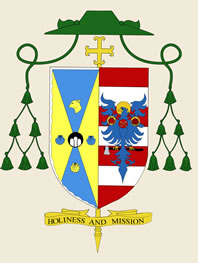 The coat of arms of a diocesan bishop is composed of the seal of his diocese and his personal arms, adopted when he became a bishop.
The coat of arms of a diocesan bishop is composed of the seal of his diocese and his personal arms, adopted when he became a bishop.
Blazon
Arms impaled. Dexter: Per saltaire Azure and Or, on an ogress between two escallops in the flanks and one in base, the chief charged with a lamb’s head couped all conterchanged, three coupeaux, one over two, Argent with a border wavy of the last. Sinister: Barry of six Gules and Argent, an eagle displayed wings inverted, Azure, haloed, beaked and member Or, holding in its talons fess wise the haft of an American woodsman’s axe Sable with the blade Argent facing Dexter base, on the eagle’s Dexter wing a bezant bearing a dolphin ancient embower Gules, on its sinister wing a bezant bearing a rose seeded and barbed of the last, and on its breast a torte bearing the crossed keys of St. Peter proper.
Coat of Arms of the Diocese of Rockville Centre
The episcopal heraldic achievement, or bishop’s coat of arms, is composed of a shield, with its charges (symbols), a motto scroll and the external ornaments. The shield, which is the central and most important feature of any heraldic device, is described (Blazoned) in 12th century terms, that are archaic to our modern language and this description is done as if being given by the bearer with the shield being worn on the arm. Thus, where it applies, that the terms dexter and sinister are reversed as the device is viewed from the front.
By heraldic tradition, the arms of the bishop of a diocese are joined to the arms of his jurisdiction, seen in the dexter impalement (left side) of the shield. In this case, these are arms of the Diocese of Rockville Centre, New York.
The arms of the Diocese are composed of four sections in alternating colors of blue and gold, representing the two counties, Nassau and Suffolk, which make up the territory of the diocese. In the upper center of these four sections is placed a lamb’s head to honor the virginal innocence of St. Agnes, titular of the Cathedral-Church in the See City and in the other three segments are scallop shells in reversed colors of the alternating fields. The shells are to pay particular honor to the heritage of the thirteen tribes of Algonquin Indians that originally inhabited the area that is now Long Island and who employed the shells of the region in so many ways. The wavy silver border of the design indicates that the Diocese is an island and at the center of the design is a black rounded charges with three rocks, as taken from the arms of Pope Pius XII who erected the Diocese in 1957, indicating by a play on words that the diocese is “rock-ville center.”
Coat of Arms of Bishop Barres
For his personal arms, seen in the sinister impalement (right side) of the shield, His Excellency Bishop Barres has retained the design that was adopted at the time of his selection to receive the fullness of Christ’s Priesthood as a bishop when he became Bishop of Allentown.
The red and silver bars are a canting device recalling the Bishop’s family surname, “Barres.” The Bishop’s immigrant ancestor, Jacob Barres came from Prussia and first settled in Lehigh County in 1852. The blue eagle with the halo is the symbol of St. John the Evangelist, honoring the Bishop’s baptismal name patron. The cross keys symbolically express the Bishop’s dedication and fidelity to the See of Peter and to the Most Holy Father, as did the arms of Bishop Barres’ predecessor, Bishop Cullen. The dolphin is taken from the arms of St. John Fisher, and the rose represents St. Thomas More, particularly his chain of office as Lord Chancellor of England. Pope John Paul II, by motu proprio in 2000, declared St. Thomas More, the Patron of Statesmen, Politicians and Lawyers. Both of these saints, one a prelate and one a layman, were martyrs for the Faith and remained loyal to the Church and the Holy See.
Their symbols are depicted in red to indicate their martyrdom. The axe represents President Abraham Lincoln, of whom the Bishop is a great admirer. The arms are completed with current episcopal indicia authorized in 1969 by Pope Paul VI, which are a gold processional cross placed in back of the shield and extending above and below it, and a round wide-brimmed green hat, known as a “galero,” containing a tassel on each side of the hat’s crown. Suspended from the gallero are six additional tassels in three rows on each side of the shield, also green.
For his motto, Bishop Barres uses the phrase “HOLINESS AND MISSION.” The Bishop’s motto derives from a phrase from the final section of the encyclical Redemptoris Missio written by Pope John Paul II in 1990, titled “The True Missionary is the Saint.”






